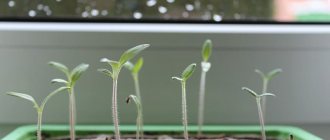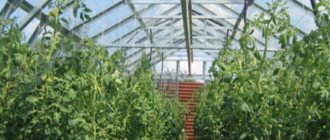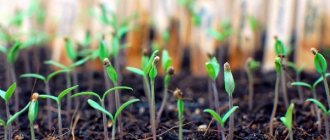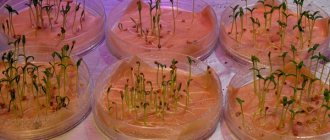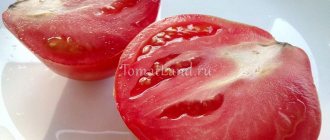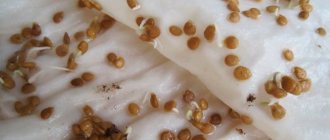It is extremely useful for any gardener to know how many days it takes for the seeds of a particular vegetable to germinate. This way, firstly, we will more accurately calculate the time for sowing seeds for seedlings. And secondly, we will save nerve cells. Should I worry that the carrots have not sprouted after five days if their germination period is up to 14 days? It's a little early, isn't it?
For convenience, we have collected in this article information on the timing of emergence of the most basic garden crops. And since the rate of seed germination is directly related to temperature, we added the minimum and optimal degrees Celsius for the appearance of the first shoots.
Description
How to germinate seeds for seedlings? Most vegetable crops are grown only through seedlings. This method is especially relevant for cold regions.
The question may arise, why grow seedlings if you can sow the seeds directly into the ground. Yes, this option is also possible, but it only applies to those crops that produce large sprouts, for example, pumpkins, legumes and others. Although they are also germinated to get a good harvest. It is worth remembering one rule: the smaller the seeds, the more susceptible they are to various problems. For example, small seeds are quickly clogged by weeds, and for garden pests small seeds are a godsend. Pest bugs destroy them very quickly, which then reduces the yield. So you need to germinate seedlings, but you can learn how to do it correctly at home from this article.
How soon will petunia sprout in a greenhouse?
Planting flowers in a greenhouse is usually carried out from late April to early May. Basically, it depends on what the weather will be like. You cannot start planting if there is at least a slight chance of frost, due to which the plant simply will not sprout.
Before planting, you need to prepare the site well, if necessary, remove last year’s soil and add fresh manure and humus. After fully equipping the greenhouse for petunia, you need to choose a separate place where daylight will not be blocked by other plants, because it is short-growing.
After this, the soil must be carefully leveled and, using a pencil, small strips should be made into which the seeds should be placed at an equal distance from each other, it should not be less than 5mm. Next, it is best to use a metal mesh. It needs to be placed above the place where the flowers are sowed, and then covered with any film.
Cling film is ideal for these purposes. This will allow you to maintain the required temperature and humidity in the area. You need to care for flowers in the same way as when planting at home.
When can you sow seedlings?
When can you sow seedlings? As a rule, for each crop, and what is there for a crop - for each variety, its own sowing period is allocated. Most often, if you buy seeds in a store, the packaging already indicates the periods during which certain vegetable crops can be sown. Don't neglect this rule.
Most often, vegetable crops begin to be planted in late February or early March. Below we suggest that you familiarize yourself with the classic seed sowing table.
| Name of vegetable crop | Timing of emergence | Age of seedlings planting |
| Cucumber | 2-3 days | 25-30 days |
| Tomato | 6-8 days | 45-60 days |
| Pepper | 12-14 days | 65-75 days |
| Eggplant | 10-12 days | 50-60 days |
| Zucchini | 3-5 days | 25-30 days |
| Pumpkin | 3-5 days | 25-30 days |
| Celery | 12-18 days | 75-85 days |
| White cabbage | 4-6 days | 40-50 days |
We remind you that the table shows the average indicators of classic vegetable crops. The timing may vary depending on the variety and type of vegetable.
If, after the seedlings have germinated, you plan to transplant them into other containers or the seedlings will grow in a greenhouse under special lamps, then you can sow them a month earlier than indicated on the package.
How to choose a container for germinating seeds?
How to choose a container for germinating seeds? Agree, this question arises immediately after you decide to sow seeds for seedlings. © https://ydoo.info/qa/kak-prorastit-semena-na-rassadu.html Before deciding on the container, think about whether you will be planting (transplanting sprouted seeds into another container for further ripening) seedlings. If yes, then you can sow the seeds in one mass in one container, dividing them by variety.
If you do not plan to pick, then it is better to immediately sow the seedlings in separate containers. There are several options for containers for seedlings:
- Peat pots are considered the best option for growing seedlings and are very popular among gardeners. And their popularity is justified. Firstly, such containers provide an almost 100% guarantee that the seedlings will take root. Secondly, the seedlings are planted in the ground along with this pot, which avoids damaging the plant or vegetable crop. Thirdly, after planting, this peat pot rots and becomes an organic fertilizer for plants. If you decide to grow seedlings in such pots, keep in mind that the soil in them should always be moist, but not soggy. It is better to place a peat pot on expanded clay or a layer of sand.
- Peat tablets are very easy to use. The peat pellet is soaked before the seed is placed into it. It swells, but only the height of the tablet increases, then they make a depression and send the seed there. The tablet already contains all the necessary fungicides and growth stimulants, so the seedlings sprout without any problems.
- Containers for seedlings are plastic containers that come in two types: cassette (divided into cells) and regular containers of different sizes and diameters. The first option, according to gardeners, is more optimal, since these are pots made of smooth plastic fastened together. Only one seed can be planted in each hole, which means the roots will not intertwine during the growing period, as happens with conventional plastic containers. However, there are also disadvantages to the cassette container: over time, when the sprouts sprout, they will crowd each other. It is best to use such containers for seedlings that do not need much time to germinate and grow, for example, cucumbers.
In fact, you can make a container from available materials, for example, from tetra pack. Just don't use plastic containers with transparent walls. The roots of young shoots do not really like light, and if it penetrates them, the plant will stop growing.
If you want to germinate a small number of seeds, for example two or three, you can use a fairly common method of germinating seeds through a sponge. This method is well suited for seedlings of hot pepper, since it is very rarely planted in large quantities, and this option will also appeal to those who live in an apartment.
To sow seeds in a sponge, you will need 2 or 1 dish sponge (soft) and the seeds you want to germinate. Sowing into a sponge occurs in several stages:
- Shallow cuts are made in the dish sponge.
- Seeds are placed inside the cuts.
- Next, the sponge is placed in a plastic container (the one in which they sell berries is very suitable).
- Now pour hot water over the sponge. The excess liquid that will drain from the sponge into the container must be poured out; the moisture should only be in the sponge.
- Next, the container with the sponge is placed in a plastic bag, wrapped (creating a greenhouse effect) and placed in a dark, warm place.
After 5-7 days, the seeds will germinate and you can transplant them into other containers. Or you can leave it for a while longer and wait for the sprouts to germinate well and rise.
If you use two sponges, you don’t have to make any cuts; the seeds are simply placed on one sponge and covered with the second, thereby creating the same greenhouse effect. The further principle of action is the same.
This germination method saves a lot of time.
How to speed up the emergence of seedlings
Soaking cabbage seeds in melt or rain water helps to shorten the germination time by several days. It will take about 12 hours. During this period, you need to change the water 3 times and carefully mix the planting material from time to time.
Next, the seeds need to be placed on a damp base, such as felt, paper, cloth or gauze. In this case, they need to be covered with the same material. Germination should occur at a temperature of 15 to 25°C.
In addition, there are more complex techniques to speed up the germination of cabbage:
- Bubbling is the essence of the method in soaking the seed in water, which is previously saturated with air.
- Hardening is a method in which seeds are alternately exposed to cold and warm air.
- Vernalization – before sowing, the material is kept for a long time at low temperatures above zero.
Before planting the material in the ground, it will be useful to warm it up under the sun's rays or lamp light for a couple of hours. This will improve the movement of juices and nutrients to the seedlings.
Why soak seeds before sowing?
Why soak seeds before sowing? Soaking is a preliminary preparation of seeds that promotes good growth. According to gardeners, soaked seeds produce strong and fairly high-quality seedlings.
After soaking, tomato seeds are not only disinfected, but their yield also increases by 30%.
Soaking seeds occurs in several stages:
- First you need to select weak, damaged and empty seeds.
- Healthy seeds are heated and treated with nutrients that are sold in garden stores.
- Next, the seeds are soaked. Place several layers of cloth in a wide container with water (any cotton fabric, gauze, cotton swabs, anything that can be folded into several layers). It is very important that the fabric is only lightly covered with water, so there should not be too much water in the container. The prepared seeds are placed between layers of cloth soaked in water. The water must be changed periodically so that it does not stagnate. Also, the tissue in which the seeds lie should not dry out, otherwise they will die.
Different vegetable crops require different amounts of soaking time. So, for example, peas take 6 hours, cabbage, cucumber and tomato seeds will need more time - 18 hours.
After soaking, the seeds are dried quite a bit and then sown in prepared containers.
Preparing seeds for planting
When preparing seeds for planting, they must be sorted and disinfected.
Sorting is done in order to select full and undamaged bobushki.
Seed sorting:
Large seeds of crops such as peas, corn, green beans are sorted by hand. It is necessary to select and throw away low-quality ones (empty, beginning to rot, eaten by insects, etc.).
- Small seeds (carrots, watermelons, garlic, melons) are selected using saline solution or water. To do this, they are poured into water, mixed, and after a few minutes the damaged particles float to the surface. But solid, high-quality ones sink to the bottom. After that, the damaged ones are drained together with water, and the good ones are taken out and dried.
- Tomato and radish seeds are selected in a 4-5% saline solution during thorough mixing. Those that float are drained, and the remaining ones must be washed several times in running water so that no salt remains on their surface, as it slows down the growth of seeds.
Seed disinfection:
- Carrot seeds are disinfected in heated water (50 ° C), holding them for 20 minutes. Then they need to be cooled in cold water.
- Watermelon, melon and peas are dried in a drying cabinet for 5 hours, periodically they must be stirred and the temperature raised to 60° C.
- Tomatoes and cucumbers are disinfected in a solution of potassium permanganate (potassium permanganate), which is prepared in a ratio of 1 g per 100 ml of water, then the seeds are washed 2-3 times in running water.
- Cabbage is kept for 20 minutes in water heated to 55°.
Disinfection is a very important point so that when planting, fungal and viral diseases are not introduced into the soil.
The right soil for seedlings
The correct soil for seedlings consists of humus, sand and garden soil, taken in a ratio of 3:4:3, respectively. It is better to prepare the soil in advance: in early autumn or summer. It will not be superfluous if you sift all the components of the substrate so that the soil turns out homogeneous and without large lumps.
The prepared substrate must be disinfected. This can be done by steaming or in the microwave.
It will be very good if you add special small processed minerals to the soil. They will help maintain good water permeability and provide the soil with air. These minerals, called “vermiculites” and “perlites,” can be purchased at any specialty store.
The finished soil mixture is poured into prepared containers so that there is still 1 cm left to the end of the container. The soil is compacted well: this must be done so that voids do not form. Afterwards, the seeds are placed in the ground and sprinkled with a small amount of soil. However, some seeds cannot be sprinkled, for example, garden strawberries: this seed needs sunlight.
Reasons for long germination
The answer to the question of why seeds do not germinate usually lies in the mistakes of gardeners. Sometimes they miss some important detail, or do not take into account the characteristics of the variety.
The biggest danger is high substrate humidity plus cold content. This combination is almost guaranteed to lead to rotting of the planting material.
Seeds are not ready for planting
Without soaking, tomatoes sprout worse. You can quickly do this on a damp cloth. After warming up and disinfection, use:
- warm water;
- stimulants;
- peroxide solution;
- complex fertilizers diluted with water.
Usually 1-2 days are enough for swelling. If tomato seeds are kept in liquid longer, they will germinate. It is recommended to plant dry only inlaid or panned ones.
Low temperature
The main factor on what day tomatoes sprout is temperature. The lower it is, the longer it will take for the first loops to appear.
If the seedling container is placed on the windowsill, then even when the room is 20° C or higher, the soil may be cold and the seeds will begin to grow. At best, they peck late, at worst, they will simply rot in the ground before they have time to emerge.
Overmoistening or overdrying of the soil
When sprouts do not appear for a long time, gardeners sometimes attribute this to a lack of water and increase the intensity of watering. But to successfully grow tomatoes, the soil must be moist, not wet. Excessive watering deprives the soil of oxygen, the seeds cannot sprout, but they rot easily.
Often tomatoes do not germinate well due to the substrate being too dry. In swollen seeds, the embryo stops developing, and those that have already sprouted die.
A crust may form on the surface due to:
- too much watering;
- water containing a lot of salts;
- using a watering can instead of a spray bottle.
Already sprouted tomato seeds cannot break through to the surface and die. The substrate does not warm up well, the access to oxygen is blocked, the water under the crust does not evaporate, while it itself has dried out. Gardeners continue to water, the grains and sprouts suffocate and rot.
Alternating periods of drought and waterlogging of the substrate is dangerous. Even adult tomatoes react poorly to this; newly hatched sprouts will die before they have time to reach the light, and the seeds will deteriorate.
Poor quality planting soil
The duration of tomato pecking is affected by an unsuccessful substrate. Therefore, it is recommended to buy it for seedlings in specialized stores. Tomatoes are prevented from sprouting:
- too dense or sticky structure, which appears only after several waterings;
- soil pests and diseases;
- excess nitrogen, the content of which is difficult to control.
Seed placement depth
Finely sown tomato seeds often suffer from dryness and may not hatch. On the other hand, if they are “buried” to great depths, they will be difficult and take a long time to emerge; in extreme cases, they will rot in the ground.
Small-fruited tomatoes
Small tomato seeds require shallow sowing. Even experienced gardeners often complain that cherry tomatoes germinate poorly, while small-fruited tomatoes can germinate without human intervention.
It is better to sow the seeds to a depth of 0.5 cm or even lightly sprinkle them with substrate. When the sprouts sprout, you can add soil to the containers.
But there is a danger of overdrying, since the surface layer quickly loses moisture. Finely sown tomatoes need to be closely monitored and the soil often but carefully moistened with a spray bottle.
Large seeds
They are sown deeper, 1-1.5 cm deep. The larger the grains, the stronger the sprout and the larger the cotyledon leaves. It is easier for such seeds to break through to the surface, so they germinate faster.
What to do to ensure that tomatoes do not sprout
After planting at any depth, even the highest quality tomato seeds will not hatch or will show disgusting germination if the seedling containers are not filled correctly. The substrate in cups or boxes must be well compacted, leaving the top 1-2 cm loose.
Otherwise, after the first watering, the tomato seeds will probably fall to the very bottom. If the container is shallow, they still have a chance to reach the surface. But these tomatoes take a long time to germinate. The seedlings will be weak.
Caring for sprouted seedlings
Caring for sprouted seedlings involves ensuring the correct temperature, watering and lighting. In order for the seeds to germinate and become viable seedlings, it is necessary to provide the correct and good light. It is believed that 14 hours of sunlight per day is sufficient for sprouted seeds. This is much more than mature plants require, so very often you have to resort to the help of special lamps.
Turn the seedlings over, twist the container and rotate it so that the seedling receives light evenly and grows well.
As for the temperature regime, for seeds it is necessary to maintain it within 22-25 degrees, but when the seeds germinate, the temperature can drop to 15-18 degrees.
Low temperatures slow down the growth of seedlings, but seedlings grown under lower temperature conditions are stronger and more viable.
The soil with young seedlings should not be dry; at the same time, water should not be retained in the soil, because excessive moisture can destroy a crop that has not yet matured. Until the seedlings sprout, spray the soil with a spray bottle, and water the grown plants with ordinary water, but at room temperature.
It is better to water adult seedlings in a tray. This type of watering will ensure a strong root system.
How long does it take for eggplant seeds to sprout?
Eggplants are rather fastidious plants, the germination of which depends on a number of factors. The main condition for the timely emergence of seedlings is the correct temperature regime. “Blue” seeds can germinate at an air temperature of +15 degrees, but in such conditions it will take a long time to wait for the first shoots.
Experienced gardeners place containers with crops in a room with an air temperature of at least +25 degrees - in a warm environment, seedlings appear within 7-10 days.
The rate of germination is also affected by how the seeds are sown. So, if they are too deep into the soil, then the sprouts will have to wait longer, and in some cases the seed material may not germinate at all. To avoid this outcome, seeds should be placed in the soil no deeper than 1.5-2 cm.
When to plant sprouted seeds?
When to plant sprouted seeds? As mentioned earlier, each variety and species is planted at different times. However, there are some rules that should be taken into account in any case:
- Cold-resistant vegetable crops (radish, carrots, parsley, dill, cabbage, beets and others) can be planted in open ground only when the earth begins to warm up to 10 degrees during the day at a depth of 5-10 cm. During the same period, you can plant heat-loving seedlings in the greenhouse vegetable crops, for example, peppers, tomatoes, cucumbers.
- Warm-loving crops can be planted in open ground only when you are sure that frosts will not return and only warm and stable weather lies ahead, without sudden changes in temperature.
Transplant the seedlings into open soil with a clod of earth, do not destroy it. In order to easily remove seedlings from the container and not damage the roots, the soil is well filled with water a day before transplanting. But on the day of planting, you cannot water the seedlings, as the soil will be too heavy and the roots may be damaged during transplantation.
As you can see, germinating seeds for seedlings is not easy. This seemingly simple matter requires a lot of attention. In order for the seedlings to turn out healthy and strong, you must adhere to the rules. But, if you make an effort, in the summer you will be pleased with the tasty and juicy vegetables that you grew yourself.
The most common methods of germination
There are several well-known methods of germination:
- Stratification is the creation of special cold conditions for planting material. This method is better suited for seeds with a hard skin (sunflower, pumpkin) and allows the seeds of these crops to germinate correctly.
- Temperature method. The seeds are placed in a cloth bag, immersed in boiling water for 3 seconds, then in ice water. After several similar procedures, a crack will appear on the seed.
- A method for mechanically accelerating germination. To do this, you need to make an incision near the nose of the seed with a knife or rub it on sandpaper, which will significantly speed up growth.
- Gauze. Allows you to germinate a seed in 2-3 days. Fold the gauze into several pieces and place it on the bottom of the container, place the seeds on the gauze so that they do not touch each other, then cover them with the same gauze and moisten it with a spray bottle; the seeds should not float in the water. Close the container and place in a dark place at room temperature. After a few days, bores of 0.5-1 cm will appear on good ones, after which they can be planted in the ground.
- Like gauze, seeds germinate in paper towels. A wet towel is spread on a saucer, the seeds are laid out on it, then they are covered with a second wet towel and a second saucer is placed on top.
- In foam rubber. Place the seeds between two wet pieces of foam, then wrap it in plastic, leaving an air bubble. After a day, the seeds should begin to germinate.
